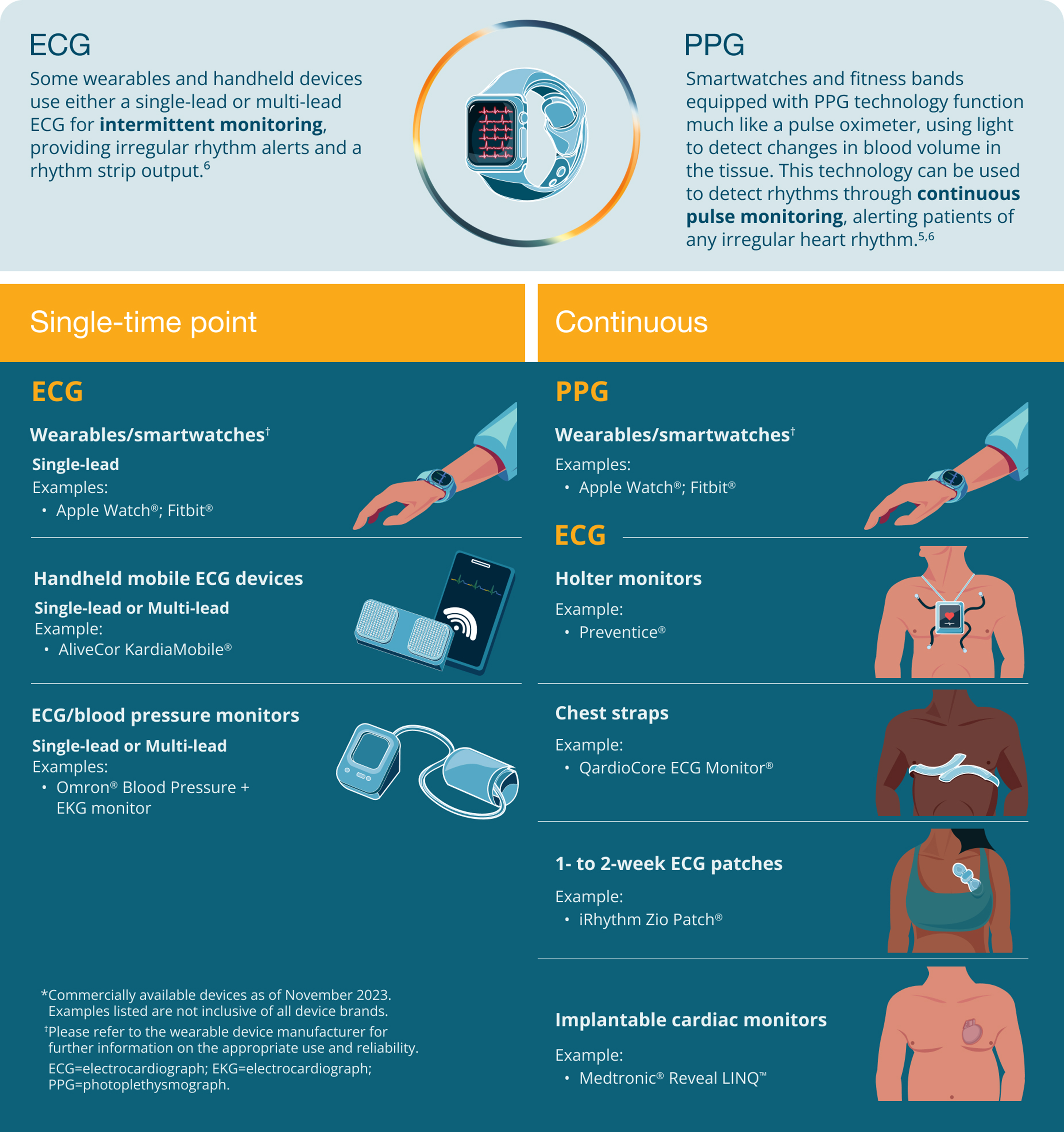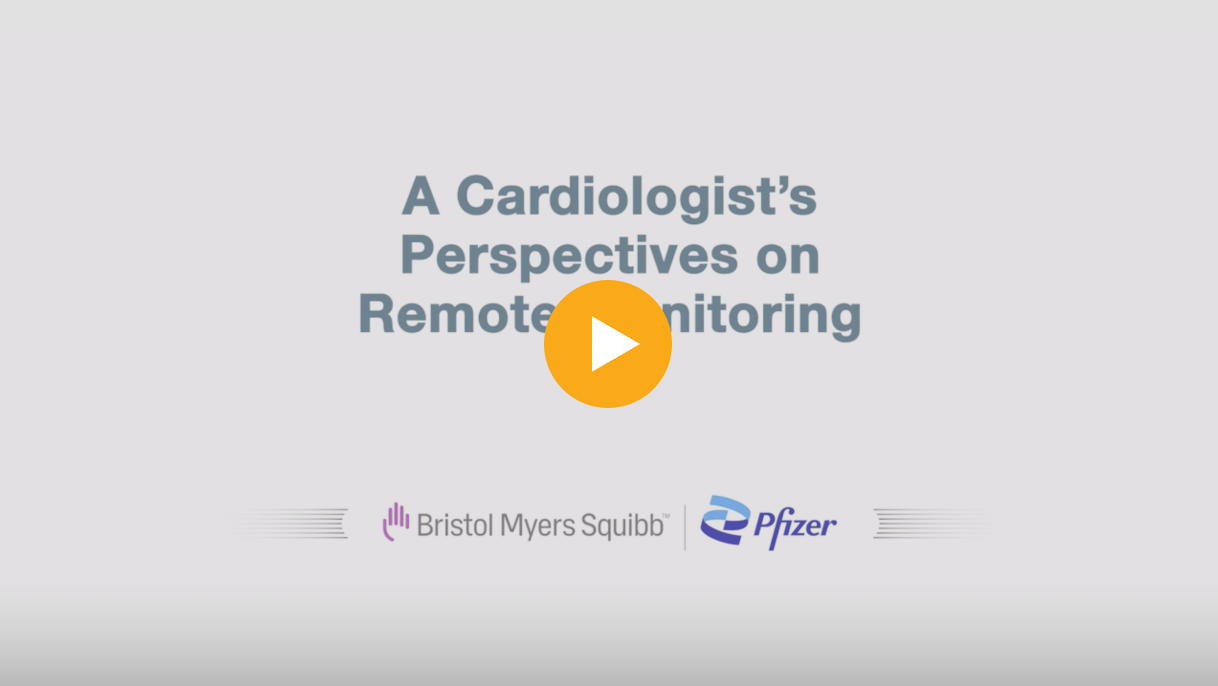This site is intended for U.S. Healthcare Professionals.
Brought to you by Bristol Myers Squibb and Pfizer
Visit Patient Site
Assessing for AFib
Assessing for AFib
When evaluating for AFib, detection can be possible through a variety of methods.1
A pulse check can help detect irregular heart rhythms, such as those in AFib. If suspected, additional monitoring or tests, such as an electrocardiogram, should be conducted to make a diagnosis.1
Detecting AFib in Your Patients
Ami Bhatt, MD, FACC, presents a hypothetical patient case and the approach to the detection and diagnosis of AFib
AFib assessment options via telehealth
The means of collecting cardiac health data continue to evolve as innovative technologies become available.2
The increased use of telehealth may require clinicians to obtain heart rhythm data in distinctive ways, starting with the pulse check, which can help detect irregular heart rhythms, such as those in AFib.3 Some patients and caregivers can be trained to take the pulse at the wrist. If any irregularities are observed, they should be reported to the healthcare provider as this can be a clue for a potential arrhythmia, such as AFib.3
Find considerations when using telehealth for remote physical exams, including remote pulse checks and heart-related tips.
If a patient mentions symptoms or reports an irregular rhythm during a telehealth visit, it’s important to schedule an in-person visit for further evaluation. At this time, a 12-lead ECG test, echocardiogram, or other diagnostic procedure may be necessary.2
If a patient mentions symptoms or reports an irregular rhythm during a telehealth
visit, it’s important to schedule an in-person visit for further evaluation. At this
time, a 12-lead ECG test, echocardiogram, or other diagnostic procedure
may be necessary.

Whether in-office or through a telehealth visit, the pulse
check is a critical step in detecting AFib.1
The FDA has cleared a number of devices to monitor heart rate and rhythm that could be used to help with assessment.2,4-5
Remote patient monitoring with wearable technology offers 2 different methods for analyzing heart rate and rhythm—electrocardiograph (ECG) and photoplethysmograph (PPG), both of which can aid in the detection of AFib.5


Please refer to manufacturer for further information on the detection algorithm used for heart rhythm and rate monitoring.
There are important considerations and potential limitations associated with different methods of AFib detection that must be independently evaluated by HCPs. Bristol Myers Squibb and Pfizer do not recommend any specific screening device or methodology. Methods/devices provided are for informational purposes only.
Fitbit® is a registered trademark of Google LLC. Omron® is a registered trademark of Omron Corporation. AliveCor® and KardiaMobile® are registered trademarks of AliveCor, Inc. Apple Watch® is a registered trademark of Apple, Inc. PREVENTICE® is a registered trademark of Preventice Solutions Inc. QARDIOCORE® is a registered trademark of Qardio, Inc. iRhythm® and Zio® are registered trademarks of iRhythm Technologies, Inc. MEDTRONIC® and REVEAL LINQ® are registered trademarks of Medtronic, Inc.
These devices went through a regulatory/clearance process and were deemed appropriate for marketed use.7 The clearance of several mobile and digital technologies for heart rhythm monitoring has introduced various options for consumer-driven arrhythmia detection and care.5,8
Monitoring for AFib beyond the office
Devices like those listed, such as wearables, can be useful assessment tools for remote patient monitoring.4 These devices can be used to:
- Monitor at-risk patients or those who require observation outside of office visits3
- Help detect irregular heart rhythm, such as AFib, in asymptomatic or previously unidentified patients5
Assessing for AFib in At-risk Patients
Ami Bhatt, MD, FACC, discusses various options that are available to detect AFib in at-risk patients
Patients are using technology to engage in their own care
Patients continue to use telehealth with HCPs, and many have turned to other forms of technology to help monitor their cardiac health beyond an in-office visit.2,6

In one online survey by The Harris Poll in 2019 of more than 2000 adults, people adopted wearables for overall health monitoring at a rate of nearly 65%, with heart rate monitoring being used at a rate of 32%4*
In a separate survey conducted by Accenture in 2020 of 2700 patients across a number of disease states, 60% reported they wanted to use technology more in the future to monitor and manage their conditions9†
A 2019 online survey by The Harris Poll of more than 2000 adults to measure usage and sentiments toward telehealth, and weighted to be representative of the general American adult population across standard demographics. This survey was commissioned by American Well (Amwell), a telemedicine company.4
A survey conducted by Accenture of 2700 cardiology, immunology, and oncology patients in the US, UK, France, Germany, China, and Japan who have been going to healthcare facilities for treatment or treating at home.9

As technology evolves, various FDA-cleared devices can be
used to remotely monitor at-risk patients for AFib.
How could remote monitoring help to detect AFib in at-risk patients?
Whether symptomatic or asymptomatic, remote monitoring may be a helpful tool in detecting AFib. Alerts from these devices help drive patients to their HCP with useful heart rhythm data, which may lead to important conversations about AFib and the related stroke risk.5
A Cardiologist’s Perspectives on Remote Monitoring
Ami Bhatt, MD, FACC, talks about remote monitoring and shares her experience with one patient in particular
According to Dr. Ami Bhatt, it’s a good idea to consider factors such as your patient’s age, lifestyle, and comfort with various health-related technology when making decisions about monitoring for AFib. Shared decision making with patients is essential when individuals are using remote monitoring devices to monitor heart rate and rhythm at home.
When discussing use of remote monitoring devices, I instruct patients on how often to monitor to help prevent over-monitoring anxiety and stress the importance of sharing device alerts with our clinical team for medical evaluation.
Data from wearable devices may inform the need for an AFib work-up. Importantly, this can potentially lead to earlier detection of AFib. Sometimes, a 12-lead ECG may not capture AFib. However, clinicians may detect paroxysmal AFib through other medical-grade devices, such as wearable patch monitors. Early detection may be key to a timely diagnosis.
– Dr. Ami Bhatt, Cardiologist
Dr. Bhatt was compensated for her time
Empowering patients to be part of their healthcare
Patient involvement in their health and the use of wearable devices generates data that can help identify irregular rhythms such as AFib in at-risk patients.3
Patients can become more involved in their healthcare

Patients can become advocates for their own care
Patients can share their device alerts and data with their physician and entire care team
Perspectives on Integrating Technology Into a Practice
Ami Bhatt, MD, FACC, shares her experience in integrating remote monitoring and data into her practice, as well as the benefits she sees for her patients
Potential benefits of remote monitoring for your at-risk patients
Better informed patient conversations
Remote monitoring may help detect and alert patients of an irregular heart rhythm, enabling informed patient conversations even with asymptomatic patients.3
Real-time
monitoring
Wearables and mobile devices may allow for
Facilitate data-sharing across care teams
Remote monitoring may allow clinical data to be shared with multiple providers, which can facilitate communication and interdisciplinary care.3

Stay AFib vigilant. Monitor at-risk patients beyond the office with
FDA-cleared devices to help detect AFib and inform a timely diagnosis.









